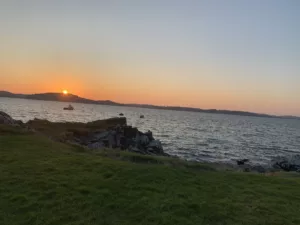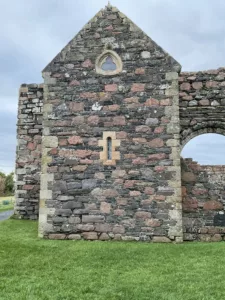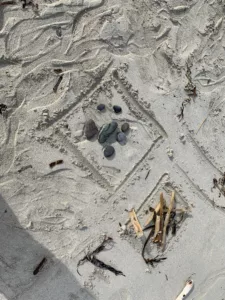Since 2018 I’ve travelled once a year to Iona. Roselle Angwin has led writing retreats there for many years, but this year she wasn’t able to. I decided to enjoy the hospitality of the Argyll hotel, meet friends who were taking part in Ken Steven’s writing retreat, and spend time on my own work.
 Early morning view across the Sound to Mull
Early morning view across the Sound to Mull
The island is one and a half miles wide, and three miles long. After St. Columba introduced Christianity to the island, pilgrims have spent time there. Indeed, there were probably Druid settlers before the conversion to Christianity. The number of current residents is estimated at 170. Thousands of visitors come and go each day during the summer months.
One of my fav places are the ruins of the nunnery.
 Ruins of the nunnery – back of the chantry
Ruins of the nunnery – back of the chantry
St Oran’s Chapel is in the cemetery and in the past Roselle’s retreaters have sung there by candlelight. It’s a bit like singing in a bathroom. It gives my voice a depth it doesn’t normally have. The nunnery sits below a rookery and I can imagine the nuns working on the island, as well as regularly praying for the community and the world.
The food at The Argyll Hotel is special. For the first time for years I didn’t eat cheese or hanker after it. Of course, there were cakes to indulge in – especially scones freshly made in the afternoon, and bread made on the premises.
That wasn’t, of course, what I was there for. For the first time I carried my ipad so I could edit poems I wanted to submit to a Cinnamon Press competition.
I’m writing a novel, called Kaleidoscope. Five characters recovering from their experiences of WW1, get caught up in riots in the centre of the city where they live. I’d written scenes about their lives, but how to describe their involvement in the riots?Gaynor Arnold, a friend from Tindal Street Fiction Group, has looked through the ideas I’d begun to consider. She suggested my job as the fiction writer was to create order in the chaos of riots.
To that end, I thought I might draw in the sand, the streets and buildings where the fighting occurred. I could choose a stone or a pebble for each of the main characters and move them as the rioting began.
I chose stones for each characters: Ethel was curvaceous, Alfred bigger and blacker in the riots than he was in the grocer’s shop where he first appeared, George was a shell. The crowd were seaweed, detritus brought in by the tide. I had good fun! I videoed the lines in the sand, giving a commentary.
A couple from Middlesborough came to see what I was doing. They told me that the founder of the Ionan Community, Rev. George MacLeod, had fought during the First World War. Afterwards, he worked to help wounded men in Glasgow, recover from their horrific experiences. I had chosen a perfect spot to work out the next stage of Kaleidoscope.
Reading and References:
Roselle Angwin- https://thewildways.co.uk/about-2 Kenneth Steven- https://kennethsteven.co.uk/
Reading: Four Windows on the Male – including my friend and poet Veronica Aaronson; Magazine: Obsessed with Pipework – varied and imaginative poetry; Precipice – Robert Harris, which I read on Kindle. It’s set at the beginning of WW1 and includes personal letters of Prime Minister Asquith to his lover, Venetia Stanley. Security lapses were at the core of the novel. Perfect for reading on long train, ferry and bus journeys. I met Florence Heyhoe who has a collection of haibuns recently published and Olive Malcolm – Sounds of Iona, whose anthology of poems is also worth reading. On the journey home, I read the inspirational, and occasionally very moving, Raynor Winn’s Landlines. To be purchased and read, Fran Hill’s Homebird.
 The Victorian Mansions where black seamen lodged, opposite the Marlborough pub where white seamen gathered.
The Victorian Mansions where black seamen lodged, opposite the Marlborough pub where white seamen gathered.
What marvellous synchronicity
Thanks, Di!
What a brilliant way to plot out your novel! And there am I planning it all out on boring post-it notes!!
I’d tried other ways at home, but it was daunting. I thought on Iona, the sea will wash it away, and I needed that kind of freedom. The drawing on the sand was playful.
Ah Marg this is lovely to read, and a bit nostalgic-making! Love your image that plots the setting and the characters in Kaleidoscope.
I love Raynor Winn’s books – have read them all now. I heard her speak at Dartington after the publication of her first – modest and humble.
Thank you for mentioning me. Rx
Thanks, Roselle! You wouldn’t need the photos of Iona itself.